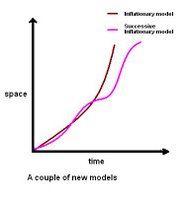Mysterious Dark Matter - invisible !
He did a close comparison.He examined the galaxies and analyzed their brightness which inturn helped him to calculate the mass.The interesting result was that he got 400 times more mass than expected.Based on this conclusion, Zwicky inferred that there must be some other form of matter existent in the cluster which we have not detected, which provides enough of the mass and gravity to hold the cluster together.A small portion is contributed by Baryonic dark matter.It is the dark matter (matter that doesn't emit light) composed of baryons, i.e. protons and neutrons.In cosmology, dark matter refers to matter particles, of unknown composition, that do not emit or reflect enough electromagnetic radiation to be detected directly
Evidence of Dark Matter
Many of these appear to be fairly uniform, so by the virial theorem the total kinetic energy should be half the total gravitational binding energy of the galaxies. Experimentally, however, the total kinetic energy is found to be much greater: in particular, assuming the gravitational mass is due to only the visible matter of the galaxy, stars far from the center of galaxies have much higher velocities than predicted by the virial theorem.
Dark matter affects galaxy clusters as well. X-ray measurements of hot intracluster gas correspond closely to Zwicky's observations of mass-to-light ratios for large clusters of nearly 10 to 1. Many of the experiments of the Chandra X-ray Observatory use this technique to independently determine the mass of clusters.
Composition of Dark Matter
Since it cannot be directly detected via optical means, many aspects of dark matter remain speculative.
Galaxy rotation curves, gravitational lensing, structure formation, and the fraction of baryons in clusters and the cluster abundance combined with independent evidence for the baryon density, indicate that 85-90% of the mass in the universe does not interact with the electromagnetic force. This "dark matter" is evident through its gravitational effect.
Hot dark matter consists of particles that travel with relativistic velocities, one of them is known as "the neutrino". Neutrinos have a very small mass, do not interact via either the electromagnetic or the strong nuclear force and are therefore incredibly difficult to detect.
MOND THEORY
Modified Newtonian Dynamics proposes to modify (F = ma), which then modifies the gravitational effects of mass. MOND predicts that Newton’s law is valid except when mass is accelerating very, very slowly. And, galaxies and systems of galaxies indeed accelerate very, very slowly over very, very long times.The MOND theory is as successful at explaining the astronomer’s observations as more standard models that assume the existence of dark matter.But this theory also has its own set of problems.
In the end, I would like to leave you with a quote
"If we accept a departure from the standard laws of physics, we might do away with dark matter."


